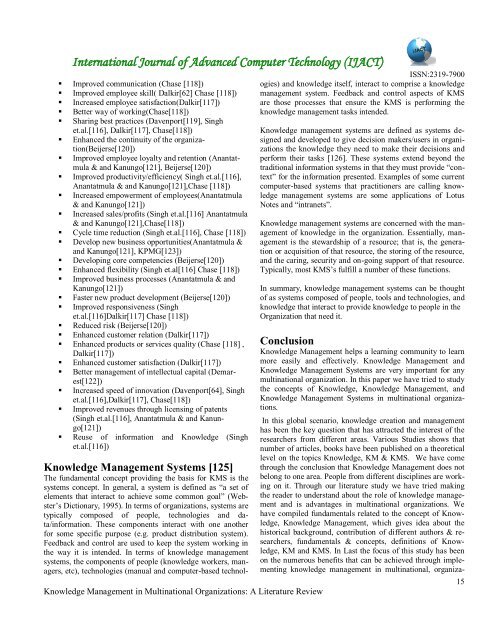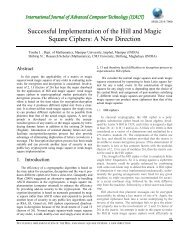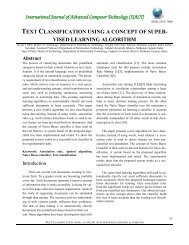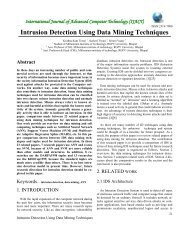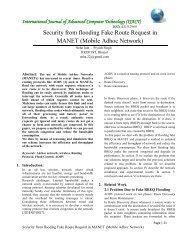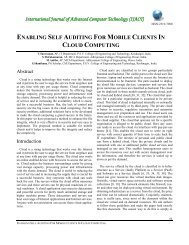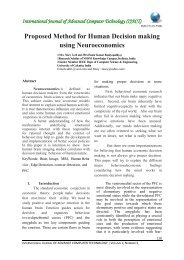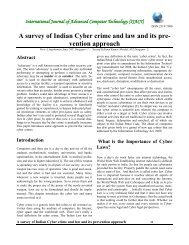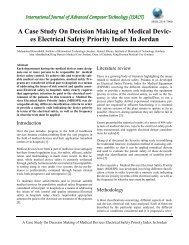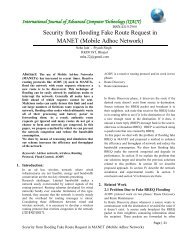A Literature Review - International Journal of Advanced Computer ...
A Literature Review - International Journal of Advanced Computer ...
A Literature Review - International Journal of Advanced Computer ...
Create successful ePaper yourself
Turn your PDF publications into a flip-book with our unique Google optimized e-Paper software.
<strong>International</strong> <strong>Journal</strong> <strong>of</strong> <strong>Advanced</strong> <strong>Computer</strong> Technology (IJACT)• Improved communication (Chase [118])• Improved employee skill( Dalkir[62] Chase [118])• Increased employee satisfaction(Dalkir[117])• Better way <strong>of</strong> working(Chase[118])• Sharing best practices (Davenport[119], Singhet.al.[116], Dalkir[117], Chase[118])• Enhanced the continuity <strong>of</strong> the organization(Beijerse[120])• Improved employee loyalty and retention (Anantatmula& and Kanungo[121], Beijerse[120])• Improved productivity/efficiency( Singh et.al.[116],Anantatmula & and Kanungo[121],Chase [118])• Increased empowerment <strong>of</strong> employees(Anantatmula& and Kanungo[121])• Increased sales/pr<strong>of</strong>its (Singh et.al.[116] Anantatmula& and Kanungo[121],Chase[118])• Cycle time reduction (Singh et.al.[116], Chase [118])• Develop new business opportunities(Anantatmula &and Kanungo[121], KPMG[123])• Developing core competencies (Beijerse[120])• Enhanced flexibility (Singh et.al[116] Chase [118])• Improved business processes (Anantatmula & andKanungo[121])• Faster new product development (Beijerse[120])• Improved responsiveness (Singhet.al.[116]Dalkir[117] Chase [118])• Reduced risk (Beijerse[120])• Enhanced customer relation (Dalkir[117])• Enhanced products or services quality (Chase [118] ,Dalkir[117])• Enhanced customer satisfaction (Dalkir[117])• Better management <strong>of</strong> intellectual capital (Demarest[122])• Increased speed <strong>of</strong> innovation (Davenport[64], Singhet.al.[116],Dalkir[117], Chase[118])• Improved revenues through licensing <strong>of</strong> patents(Singh et.al.[116], Anantatmula & and Kanungo[121])• Reuse <strong>of</strong> information and Knowledge (Singhet.al.[116])Knowledge Management in Multinational Organizations: A <strong>Literature</strong> <strong>Review</strong>Knowledge Management Systems [125]The fundamental concept providing the basis for KMS is thesystems concept. In general, a system is defined as “a set <strong>of</strong>elements that interact to achieve some common goal” (Webster‟sDictionary, 1995). In terms <strong>of</strong> organizations, systems aretypically composed <strong>of</strong> people, technologies and data/information.These components interact with one anotherfor some specific purpose (e.g. product distribution system).Feedback and control are used to keep the system working inthe way it is intended. In terms <strong>of</strong> knowledge managementsystems, the components <strong>of</strong> people (knowledge workers, managers,etc), technologies (manual and computer-based technol-ISSN:2319-7900ogies) and knowledge itself, interact to comprise a knowledgemanagement system. Feedback and control aspects <strong>of</strong> KMSare those processes that ensure the KMS is performing theknowledge management tasks intended.Knowledge management systems are defined as systems designedand developed to give decision makers/users in organizationsthe knowledge they need to make their decisions andperform their tasks [126]. These systems extend beyond thetraditional information systems in that they must provide “context”for the information presented. Examples <strong>of</strong> some currentcomputer-based systems that practitioners are calling knowledgemanagement systems are some applications <strong>of</strong> LotusNotes and “intranets”.Knowledge management systems are concerned with the management<strong>of</strong> knowledge in the organization. Essentially, managementis the stewardship <strong>of</strong> a resource; that is, the generationor acquisition <strong>of</strong> that resource, the storing <strong>of</strong> the resource,and the caring, security and on-going support <strong>of</strong> that resource.Typically, most KMS‟s fulfill a number <strong>of</strong> these functions.In summary, knowledge management systems can be thought<strong>of</strong> as systems composed <strong>of</strong> people, tools and technologies, andknowledge that interact to provide knowledge to people in theOrganization that need it.ConclusionKnowledge Management helps a learning community to learnmore easily and effectively. Knowledge Management andKnowledge Management Systems are very important for anymultinational organization. In this paper we have tried to studythe concepts <strong>of</strong> Knowledge, Knowledge Management, andKnowledge Management Systems in multinational organizations.In this global scenario, knowledge creation and managementhas been the key question that has attracted the interest <strong>of</strong> theresearchers from different areas. Various Studies shows thatnumber <strong>of</strong> articles, books have been published on a theoreticallevel on the topics Knowledge, KM & KMS. We have comethrough the conclusion that Knowledge Management does notbelong to one area. People from different disciplines are workingon it. Through our literature study we have tried makingthe reader to understand about the role <strong>of</strong> knowledge managementand is advantages in multinational organizations. Wehave compiled fundamentals related to the concept <strong>of</strong> Knowledge,Knowledge Management, which gives idea about thehistorical background, contribution <strong>of</strong> different authors & researchers,fundamentals & concepts, definitions <strong>of</strong> Knowledge,KM and KMS. In Last the focus <strong>of</strong> this study has beenon the numerous benefits that can be achieved through implementingknowledge management in multinational, organiza-15


